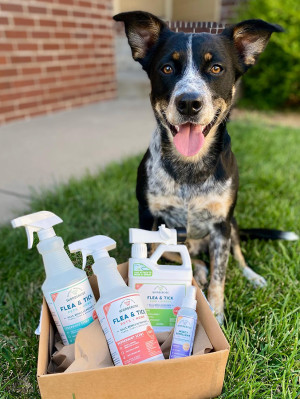What to Do About Bug Bites on Your Dog
And how to help them get relief.

Share Article
In This Article:
Is This A Bug Bite on my Dog? How to Identify Different Types of Bug Bites on Dog How To Treat Bug Bites on Dogs
There’s nothing subtle about an itchy dog: They scratch, they chew, they rub their faces and bodies against the floors, the furniture, and even you, trying to find relief from their itch. Bug bites are common causes of itchy skin in dogs, and some dogs may be more sensitive to their bites than others.
Depending on where you live, your dog may be exposed to certain insects year-round or seasonally, which may help explain the pattern to their itchiness. The good news is that insect bites usually only cause temporary discomfort, and there are many effective strategies to protect your pup and sooth their itch. Read on to learn all about bug bites on dogs.
Is that a bug bite on your dog?
You may discover your dog has bug bites in a number of different ways. First, you may find the actual bug culprit on your dog or in your home. Second, you may notice a swelling, small scabs, or bumps on your dog’s skin. Other times, you don’t find any definitive evidence on them, but you notice you have a very itchy dog and some suspicious bites on you.

Different kinds of insect bites cause unique signs in dogs with some bites localized to specific parts of the body and causing varying degrees of itchiness. Depending on the specific signs your dog has, you may be able to identify the type of bug that bit them, while other times you may need your vet’s help to determine what’s going on.
How to identify different types of bug bites on dog
Like us, dogs experience different kinds of bug bites differently. Dogs are the preferred host for some bugs, meaning they have evolved to feed mainly on dogs, and may even live on dogs during part of their lifecycle. Other insects have different preferred hosts but may occasionally feed on dogs when the opportunity arises.
Understanding the lifecycle and preferences of different bugs is important for knowing how to identify them, what their bites may look like, as well as other signs of their presence. The more you know about these tiny enemies, the better you can fight back to protect your dog and get rid of these unwanted invaders. Some basics to get you started include:
Flea bites: Fleas are one of the most common skin parasites in dogs. Cat fleas, Ctenocephalides felis, are the most common species of flea found in the U.S., and they are adapted to use both dogs and cats as their primary hosts. This means that they can live and reproduce on dogs in addition to biting them. Flea bites are extremely itchy and tend to be most obvious around the base of the tail, belly, and hind legs, but they can be found anywhere. They may result in very small red, scabbed bumps on the skin. Dogs who are hypersensitive to flea saliva will have much more severe skin reactions, including hair loss, severely inflamed skin, and even secondary skin infections. It is common to find live fleas on dogs that are infested with fleas as well as flea dirt, which looks like black dandruff and is actually flea poop.
Tick bites: There are many different species of ticks worldwide, and depending on where you live, certain species may be more prevalent. Different species of ticks also have different life cycles and prefer different hosts. Tick bites may not be as obvious as other insect bites. Instead, ticks tend to stay in place to feed once they latch on. Most often, pet parents will see or feel a bump on their dog and discover a tick that is latched on or find a tick in their home after it has fallen off. Ticks tend to seek out dark, warm spots on dogs so they will often be found near the ears, under the collar, around the armpits or under the tail. Ticks can carry diseases transmissible to both humans and dogs so it is important to wear gloves and remove ticks properly.
Mosquito bites: There are many species of mosquitoes, each with their own preferred hosts. Many mosquitoes can and will feed on a variety of mammals, including humans and dogs. Mosquitoes need warm, moist conditions to reproduce and do not survive in freezing temperatures. Depending where you live, mosquitos may be a problem year-round or only seasonally. The most common locations for mosquito bites on dogs are on the ears and other hairless parts of the dog. These may look like firm, raised bumps on the skin. For dogs that are hypersensitive to the bites, they may also develop more severe reactions including redness, swelling, or hair loss. Mosquitoes can transmit heartworm disease to dogs, so even if your dog does not have obvious mosquito bites, it’s important to use routine preventatives to protect them against heartworm.
Bed bug bites on a dog: As gross as it may be, humans are actually the preferred hosts for bed bugs, so dogs don’t get lots of bed bug bites. However, if there is a bed bug infestation in your home, your dog may get bitten incidentally. Typically the humans in the home will be most affected and will have red, itchy bites. Bed bugs come out at night so if your dog seems itchier at night, or you are seeing the bugs only after dark, be suspicious.
Ear mites: Ear mites are parasites that live inside the ear and are extremely itchy. Dogs with ear mites will often be shaking their heads frequently, scratching at their ears, or rubbing their ears on the floor and furniture. Their ears may look crusty, and they may have a bad odor or excessive discharge in their ears. Ear mites are not easily visible with the naked eye and your vet will typically make the diagnosis after looking at a sample from the ear under a microscope.
Skin mites: Skin mites are also parasites that live and reproduce on dogs. There are many different kinds of skin mites, each with a different lifecycle and classic pattern of infection. Some tend to make dogs extremely itchy, like Sarcoptes, the cause of Scabies, while others, like Demodex, tend to be less itchy. These mites are only visible with a microscope.
Hot spot on dog: A hot spot is a skin reaction that can be caused by many different irritants. These are areas of moist, inflamed, skin that become extremely itchy, painful, and often develop secondary infections. They can be caused by insect bites, skin allergies, environmental irritants, or anything else that damages the surface of the skin.
Other bumps: Many skin conditions can look similar to bug bites but have very different causes. This includes allergic reactions that cause hives, skin infections, cysts, tumors, and even normal anatomy like nipples, which both male and female dogs have. If your dog has bumps on their skin that you can’t identify, or that don’t seem to be going away, be sure to see a vet.
How to treat bug bites on dogs
Treating bug bites requires a multi-step approach to soothe your dog’s discomfort, eliminate an infestation, and prevent future bites. Depending on the specific bug that is causing the problem, these steps require different approaches. This may include:
Natural remedies for bug bites on dogs: Some natural remedies may be helpful in relieving your dog’s itch and soothing their discomfort. This includes cold compresses to reduce inflammation and itch. Other soothing products like colloidal oatmeal, found in many shampoos, can also be soothing.
Over-the-counter options: Dogs that are hypersensitive to insect bites from mosquitoes or fleas may benefit from an antihistamine like Benadryl to help relieve their itchy, inflamed skin. It is very important to consult with your vet before starting any over-the-counter medications; some are contraindicated in dogs with underlying medical conditions or on certain prescription medications.
Medical treatments: Medical treatments are necessary to treat many of the bugs that infest dogs, like fleas and mites. This may include topical products applied directly to the skin, or systemic medications given by mouth to eliminate the infestation and bring your dog lasting relief. Dogs who develop hypersensitive reactions to bug bites or secondary skin infections may also require additional medications to heal their skin.
Environmental control: It is important to take steps to eliminate bugs from your home and local environment as much as possible to protect your dog. For example, flea infestations require thorough decontamination of the environment. This includes vacuuming, cleaning hard surfaces, washing all fabrics and/or disposing of materials that cannot be deep-cleaned to remove eggs and larvae that will otherwise re-infect your pets.
When it comes to mosquitoes, be sure to eliminate any sources of standing water on your property where they may lay eggs. Keep vegetation well-trimmed in the fenced-in section of your yard to reduce the chances of your dog brushing up against leaves and grasses preferred by ticks.Preventative measures: When it comes to bug bites, prevention is key. There are many highly effective preventative products that target fleas, ticks, and heartworm and will keep your dog from developing more serious complications of these infections. Be sure to consult your vet to determine which products are most appropriate for your dog given their medical history, lifestyle, and where you live.
Other preventative measures you can take include brushing your dog daily, especially after hiking or off-leash adventures in thick brush or vegetation. This will help you to remove any insects from their fur and give you a change to check them over for ticks or other hitchhikers. Finally, be sure to keep up with routine medical care, check-ups, and vaccinations.
When to seek expert help
Anytime your dog seems itchy, uncomfortable, or develops a new lump or bump on their skin, it’s a good idea to have your vet examine them. Many skin problems can look similar on the surface and it can take a professional with the right tools to accurately diagnose the problem and prescribe the most effective treatment. This is especially important if your dog’s skin problem seems to be getting worse, develops a bad odor, or is accompanied by other signs of illness like lethargy, or changes in their appetite. Your vet is also a great resource for tips and tricks to get rid of infestations like fleas, so even if you know what the problem is, you may want to seek expert help to get the problem under control as quickly and efficiently as possible.
Bottom line
Just like us, dogs can suffer from many different kinds of insect bites.
Insect bites can resemble many other skin conditions, so it is important to seek veterinary care if you are unsure what’s going on with your dog’s skin.
Many insects can also transmit diseases, so be sure to use safe and effective preventatives to keep your dog protected year-round.
References
Beugnet, F, et al. “Insecticidal efficacy of afoxolaner against bedbugs, Cimex lectularius, when administered orally to dogsopens in new tab.” Parasite, vol. 28, no. 7, 2021.
Fletcher, MG, et al. “Susceptibility of the bedbug, Cimex lectularius, to selected insecticides and various treated surfacesopens in new tab.” Medical and Veterinary Entomology, vol. 7, no. 1, January 1993, pp. 69-72.
Littman, M. et al. “ACVIM consensus update on Lyme borreliosis in dogs and catsopens in new tab.” Journal of Veterinary Internal Medicine, vol. 32, no. 3, March 2018, pp. 887-903.
Nelson, CT, et al. “Highlights of the canine guidelines for the prevention, diagnosis, and management of heartworm infection in dogsopens in new tab.” American Heartworm Society, 2024.
Zentko, D, et al. “Featured creatures: cat flea.opens in new tab” University of Florida Entomology and Nematology. Published July 1997. Reviewed April 2021.

Dr. Amy Fox, DVM
Amy Fox, DVM is a small animal veterinarian in New York City with over thirteen years of experience in a mixture of general practice, emergency medicine, and shelter medicine. A lifelong animal lover, Dr. Fox studied biology in college and then worked as a veterinary nurse before pursuing veterinary school at Cornell University. Her expertise includes surgery, dentistry, and management of chronic conditions, and she is interested in toxicology, pain management, nutrition, care of senior pets, and educational outreach. Dr. Fox also enjoys writing about veterinary medicine and teaching, and her work has previously appeared in Spruce Pets. In her free time, she loves to cook, garden, go for long runs, and hang out with her goofy mixed-breed dog May, who provides never ending comic relief!
Related articles
![Dog sitting behind a basket of Wondercide products on the grass outside]()
Mosquitos Aren’t Going Away — Neither Are Bug Sprays That Are Toxic to Dogs
Enter: Wondercide, a plant-based, sustainable, pesticide-free mosquito-repellent set safe to use around your pet.
![Little dog getting showered by his owner in the backyard.]()
How to Treat Dog Skin Diseases at Home
And how you might safely give your pup immediate relief.
![Woman playing outside with her dog.]()
The 5 Best Pet-Safe Mosquito Sprays to Protect Your Pup This Summer
Plus, an option if you live in a household with dogs and kitties.
![A woman in beige overalls a striped shirt and a straw hat, smiling, with her arm around her black dog sitting in the grass on a green hill.]()
How Did I Get a Flea Infestation? Causes and Prevention
Treatments to ward off transmission this spring and summer.
Can You See Fleas on Dogs?
Come out, come out wherever you are, you little pests.
![A woman checking her dog for ticks outside in a grassy field.]()
Can Dogs Get Lyme Disease? Canine Lyme Disease Symptoms, Treatment, and Prognosis
It is peak tick season, so we asked a veterinarian for tips on how to prevent this dreaded disease.








